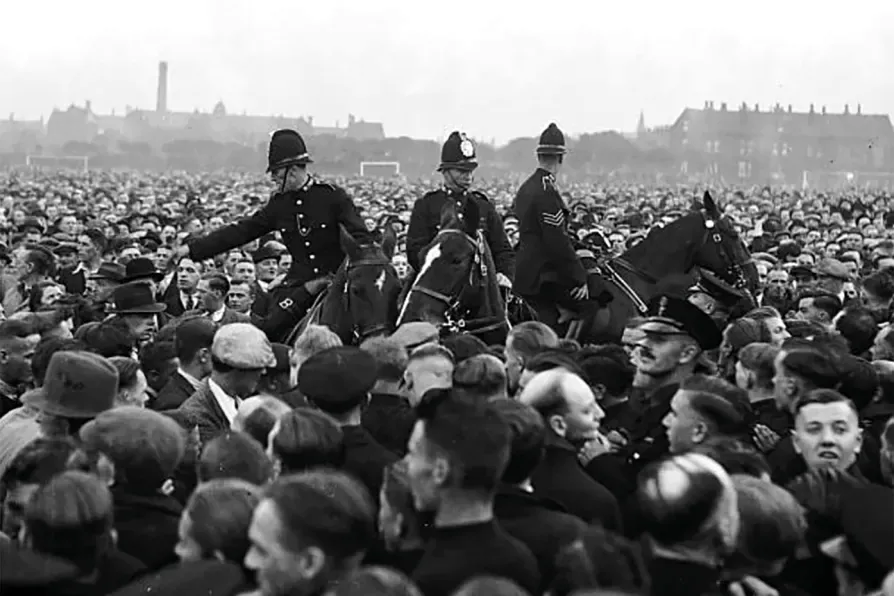From London’s holly-sellers to Engels’s flaming Christmas centrepiece, the plum pudding was more than festive fare in Victorian Britain, says KEITH FLETT
We must remember how the CPGB led anti-fascist movement defeated Mosley’s BUF in September 1936 and apply the lessons of mass mobilisation and open, unapologetic confrontation to the rise of the far right today, writes DYLAN MURPHY

 PRECURSOR TO CABLE STREET: The crowd at Holbeck Moor with police cavalry; and (below) Oswald Mosley ranting into a microphone in 1936
PRECURSOR TO CABLE STREET: The crowd at Holbeck Moor with police cavalry; and (below) Oswald Mosley ranting into a microphone in 1936
THE rise of Reform UK, now polling as Britain’s most popular political entity, coupled with the influence of movements like Tommy Robinson’s, poses a significant and urgent challenge to the British labour movement. Understanding historical responses to fascism can inform current strategies to counter such threats.
The examination of past struggles against fascism transcends mere historical inquiry. It serves as a vital opportunity to extract crucial lessons from the past, lessons that remain profoundly relevant in our current political landscape.
The resurgence of fascism in Europe during the summer of 1936 helped revive the fortunes of the British Union of Fascists (BUF). Following its defeat during 1934, when the BUF was swept off the streets of Britain, the BUF saw a resurgence in its membership and activity.
Encouraged by events on the continent and the support he was receiving from sections of big business, Oswald Mosley launched a new recruitment campaign for his ailing fascist movement. This was accompanied by provocative marches through Jewish areas of London and other cities such as Leeds.
Most accounts of the anti-fascist movement focus on events in London and, in particular, the Battle of Cable Street in October 1936, which saw a defeat inflicted on the Blackshirts.
As important as this was, we should not forget that the BUF were facing ferocious resistance up and down the country, which also played an important role in the demise of the Blackshirt movement.
At this time, Leeds had the highest Jewish population in Britain outside of London. Throughout the 1930s, Leeds remained one of the few areas where the BUF enjoyed consistent support.
The Blackshirts were able to draw support from the strength of anti-semitic feeling in certain parts of the city. Support for the Blackshirts in Leeds appears to have been concentrated in the Armley and Burley areas.
When Mosley announced his intention to hold a rally in Leeds on September 27 1936, the local Communist Party of Great Britain (CPGB) branch advocated a counterdemonstration to stop the BUF march and rally taking place.
Mosley’s intention was to march through the Jewish section of the city, believing himself to be safe due to the heavy police protection which his activities had enjoyed since 1934. It should be added that throughout 1936, the local fascists had made regular attacks on Jewish homes and shops and physically assaulted several Jewish people.
Mosley was surprised to receive a rebuff from the Assistant Chief Constable Frank Schwaby, who refused to let the BUF march through Chapeltown as he “deemed it to be more trouble than it was worth in the face of the mounting campaign of public opposition” to the BUF’s proposed march. Instead, Mosley had to settle for a public rally on Holbeck Moor, which was on the outskirts of the city.
The Leeds CPGB was unanimous in its decision to try to stop the Blackshirts’ march and rally. Its appeal to the local labour movement for a mass mobilisation to stop the BUF march was rebuffed by the local Labour Party and trades council.
However, thousands of local trade unionists, along with many Labour Party members, responded to the local CPGB’s appeal. The local branch of the Independent Labour Party also threw its weight behind the campaign to mobilise a mass counterdemonstration against the Blackshirts.
On September 27 1936, a uniformed BUF contingent, about 4,000-strong, set out from Calvary Street up to Holbeck Moor. As the Blackshirts reached Holbeck Moor, they were greeted with cries of “Murderers” and “Get back to Germany” from 30-50,000 anti-fascists. Several hundred police, both mounted and on foot, kept the anti-fascist counterdemonstration from swamping the BUF contingent.
As soon as Mosley started speaking, he was greeted by a hail of stones and chanting, which drowned out his speech. The police response to this was to mount baton charges into the huge crowd of anti-fascists.
Dozens of people were injured by these baton charges. This police violence encouraged the Blackshirts, who also began to attack the crowd of anti-fascists, knocking several people unconscious. Having said this, scores of people, mainly fascists, were injured by the barrage of stones with which Mosley’s rally was pelted.
Despite the assaults of the police and Blackshirts, the massed ranks of the counterdemonstration kept up its chanting, which prevented Mosley from speaking. Mosley was forced to abandon his attempt to address his contingent of Blackshirts and was escorted off Holbeck Moor by the police. The police, with great difficulty, managed to clear a path for the fascists to escape off the moor.
Throughout their retreat back to the city centre, the Blackshirts were bombarded with stones. In Domestic Street, the fascists were confronted with a barricade built by local workers.
From behind this barricade, they pelted the Blackshirts with stones. It was at this point that Mosley was hit on the temple, and the police launched another baton charge into the crowd. During these violent encounters, a mere three anti-fascists were arrested by the police.
After the BUF had been driven off Holbeck Moor, the local CPGB group held an anti-fascist rally. Communist Party speakers emphasised that the struggle against the BUF was part of an international movement against the menace of fascism.
They drew attention to the Franco uprising in Spain and called for support for the British battalion of the International Brigade, which would play a heroic role in the fighting against Spanish fascism and its German and Italian backers. At the end of the rally, a collection was held to pay for a defence fund for those who had been arrested by the police.
The defeats inflicted on the BUF in rapid succession at the Battle of Holbeck Moor and the Battle of Cable Street were to bring to a premature end Mosley’s campaigning work in 1936.
The mass anti-fascist movement was the crucial factor in undermining the BUF’s ambitions to become a mass party. It demonstrated the power of grassroots activism and direct action in confronting and defeating the fascist threat.
Looking back on these events in 1948, one anti-fascist of this period noted that the united actions of the workers, “…demonstrated anew the lesson: only vigorous counter-action hinders the growth of the menace of fascism.”
Dylan Murphy is a labour movement historian who has researched the struggle against fascism for his doctorate.










